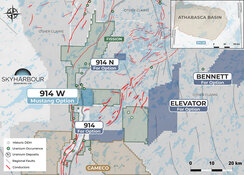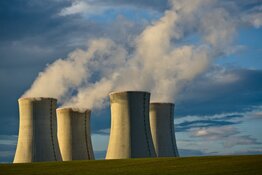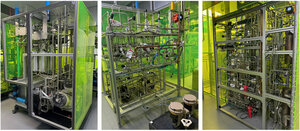Alka Singh: At Rodman, I cover all of the mining sectors—precious and base metals, as well as uranium. For the last two years, and particularly for the last 12 months, I've been telling investors to take profits from some of the gold equities that have run up 300%–400% and put those profits into uranium equities. People had been very skeptical in the beginning of 2010. Uranium prices remained at the $41–$42 level for very long; investors thought that the sector was likely dead. Why invest in uranium stocks when they were already getting crazy returns on gold and other precious metals? Then suddenly, about two to three months ago, the price of uranium started coming back. The uranium price went up from $42 to $62.50, where the uranium spot price is today. Obviously, uranium prices had to play catch-up and they did for a few reasons.
Supply and demand for the medium and long term was always very positive for uranium prices, but I think the depreciating U.S. dollar also played a role. Most commodities—gold, silver, copper, lead, zinc and, to some extent, even coal—ratcheted up on the tanking USD while uranium prices did nothing. Uranium had to play catch-up, and that's what drove the price up.
Together with the supply/demand fundamentals, the uranium price rose to $62.50 and I don't think uranium price appreciation or uranium equities are done quite yet. If you look at the last cycle that began in 2005, the uranium price rose sharply to about $139/lb. in 2007 before coming back down. The difference back then, I think, was that a lot of speculation fueled uranium's price rise.
This time around, something different is going on. The Highly Enriched Uranium (HEU) Purchase Agreement accord to convert 500 metric tons of HEU to low-enriched uranium (LEU) with Russia is supposed to expire in 2013. Russia has already told the U.S. that it will not renew it. As you know, 65% of the global uranium supply comes from HEU. This will have a dramatic effect, and people have now started pricing that in. So, that is my bullish case for uranium.
Additionally, China has started buying. Recently, China announced a deal with AREVA (PAR:CEI) and then another one with Cameco Corp. (TSX:CCO; NYSE:CCJ). So, it's still trying to get uranium to fuel the country's nuclear power reactors. I think China will be home to the more than 40 nuclear power reactors over the next 10–15 years. So, that's driving the uranium price.
Then there's India, which also has signed a few agreements. One of the deals was with France to get help in setting up new nuclear power plants. So, from the demand perspective, uranium demand will continue to drive the price of uranium in the future.
TER: Alka, as the U.S. begins to decommission some of its nuclear warheads and does something like the HEU agreement internally, is there a possibility to produce uranium stockpiles in and for the U.S.?
AS: Well, that's another very good question. I don't think that the U.S. has said anything publicly about what they want to do. But if you look at what the U.S. has done in the past, it has sold some of its stockpiles. But they didn't want to have an impact on the uranium's market prices, and whenever prices were too high they tried to sell some. Whenever the prices were too low, they actually did not sell any. So, I think it's more that they tried to stabilize the price rather than do any sort of market manipulation with the price. But I don't think U.S. is going to start decommissioning these warheads and putting the uranium out into the market. At least in the near term I don't think that's happening.
TER: Can uranium get back to the 2007 levels of $135–$139? Do you believe that's possible?
AS: That is possible. As we all know, commodity cycles always go to one side or the other, and when they're going higher you see them overshoot. When you see them going down, it's the same. When uranium prices were at $40, there were very few companies that were actually profitable at that level. You saw that Denison Mines Corp. (TSX:DML; NYSE.A:DNN) had to put their projects in Mongolia and Zambia on hold because they required a uranium price of $60 just to break even. So, a $40 uranium price was probably OK for the Russians who are just blending down the HEU into LEU. When I was at Merrill Lynch, before joining Rodman, I used to cover Cameco, which has a pretty low cost of production. At that time they were producing uranium from McArthur River at $17–$18 a pound, which was pretty cheap. But not everybody has these same sorts of projects with such low costs.
So, some of the mines in Kazakhstan, Mongolia and Zambia that were at a feasibility stage at that time had production costs of about $45–$50, and then if you add in the capital-expenditure (capex), they needed a $65– $70 uranium price to break even. It all depends on the circumstances. If demand keeps growing as it is right now and you see oil prices going up back to the $140– $150 level, you will see uranium prices go back to $135– $138/lb.
TER: As you said, we've had a very steep rise, to over $62 today. Is there any chance that we're in a short-term or intermediate-term bubble?
AS: I really don't think so, especially since the utilities have just started coming into the market. They had been sitting on the sidelines for two years. They probably had enough inventories for 2009 and 2010, and so they did not actually participate in the spot market at all for the long term. But now we are seeing the utilities coming back.
In fact, right now is actually the slow season. December is holiday time, and I don't think a lot of deals are getting signed. If you saw the recent UX Consulting report, you would see that most of the deals were only done on the spot. There were no term deals done this week. So I think things will start picking up early next year when utilities start coming back to the market to get more security and supply for the next five to eight years. They typically do between three- and eight-year contracts. When I was at Merrill, we did this report where we looked at uranium prices for the last 20 years, and between February and May we saw the largest increase in uranium prices. So, if utilities again come to the market between February and May of 2011, you could see another leg up. I wouldn't call it a spike because that's coming from real demand. I'll call it a seasonal increase in demand and an increase in uranium prices.
TER: Alka, it sounds like you do not believe that uranium is a mature industry but rather still a growth industry.
AS: No, I really don't think that uranium is a mature industry at all. If you look at the cost of electricity generation comparing nuclear to gas, nuclear to coal or nuclear to hydro, you will see that nuclear is the second cheapest source of energy after coal. But with coal you have other problems with environmental concerns. So, the only other alternative is nuclear. Most of the hydroelectric projects in the world have already been built, so it would be very difficult to double hydroelectric generation. It's just not doable. But with nuclear, you can do it, although it's more expensive.
Nuclear power plants are very, very expensive. Permitting is a big risk and very time consuming. Nuclear is the only way you can get more electricity generation at a low cost and be stable enough to provide base load power. I don't think that wind power or any other green power generation is actually suitable for base load. Wind power is great when the wind is blowing and you actually generate electricity. But when there's no wind, the windmills themselves actually draw electricity from the grid. So, that's not good for base load. For base load you need hydroelectric, coal, gas and nuclear—that's it. And with nuclear being the second cheapest, you have to go nuclear.
TER: Now that you've established this growth hypothesis, what catalyst should investors anticipate going forward for uranium equities?
AS: Well, I cover three uranium names. I cover Uranium One Inc. (TSX:UUU), Uranium Energy Corp (NYSE.A:UEC) and Ur-Energy Inc. (NYSE.A:URG; TSX:URE) in the U.S. My two favorite names right now would be UEC and URG just because there are really a lot of short-term catalysts that can keep these equities going higher.
URG has a few permits that they are waiting on, but the key one is the Nuclear Regulatory Commission (NRC) permit. If they don't get it next week then it has to be in early January. They need that one, but after that they have to get another permit from Wyoming Department of Environmental Quality (WDEQ) and then another one from the Bureau of Land Management (BLM), which is the last permit that they need. So, every time the company gets a permit that would be a catalyst for the stock to go higher.
UEC just got their permit for the Goliad project, which we had anticipated, but there had been a lot of negative news on Goliad such that the company might not have been able to get their permits. But they did. So now they're waiting for radioactive material license (RML) from the Texas Commission of Environmental Quality (TCEQ), which they'll probably get by January to start construction at the Goliad project.
So, these are the two companies with a lot of catalysts happening in the near future. I really think these are the two companies in which investors should definitely be long on in order to take advantage of this rally in uranium prices. That's especially true because both of these companies are new producers (UEC just started production at their Hobson plant and URG will commence production in early 2012) and will be producing uranium through the in situ recovery (ISR) facility, which is much cheaper than conventional mining.
TER: What about additional expansion with UEC?
AS: In 2011, UEC will probably be producing close to a million pounds (Mlbs.) of uranium. In 2012, I think they're going to go up to 2 Mlbs. with no additional capex required because the Hobson facility is actually built for 2 Mlbs. They can actually take the Hobson processing facility up to 2.5–3 Mlbs. if they really wanted to by adding an additional dryer for another million dollars. All they need to do is find more uranium in the ground. So, I don't think the Hobson plant is a bottleneck. The bottleneck would be getting Goliad and Palangana projects up to 2.5–3 Mlbs. a year in total.
TER: How long will it take to get the Goliad Project up to that level of production?
AS: If they get their permits in January, they will start building the satellite project at Goliad, which will probably take three to four months to get up and running.
TER: You said you were very positive on Uranium Energy as well.
AS: Yes, I am. There are four permits required, and hopefully they will get the first one in early January. The last permit will be from the BLM, which they expect to get in the second quarter of 2011. Once they get that permit they'll take six months to build the project, and then they'll be in production in early 2012. So those are the catalysts—four permits over the next six months, then they'll announce construction, and then they'll announce production startup in early 2012. That's the kind of timeline that we are talking about right now for URG. So as you can see, URG has more short-term catalysts than UEC just because UEC is already permitted.
TER: Do both UEC and URG have the ability to expand with new leases and potentially M&A?
AS: Yes, they do. You're absolutely right there for both of these companies. URG has two projects, Lost Creek and Lost Soldier. Just between those two, they can actually get up to 2–2.5 Mlbs. of uranium production per year. UEC can also get up to that 2–2.5 Mlbs. level with Palangana and Goliad, and they also have other leases they are looking at in Texas. URG is looking at some leases in Wyoming, and they have other projects as well, but we are not giving any value to them right now. Even with what they have, URG can get up to my target price of $3. For UEC, my target price is $6.50, which it has recently exceeded and then went down to $5. Those are my target prices which don't even include any additional leases or any increase in production from the 2 Mlbs. level for either company.
TER: Will UEC and URG need additional financing to proceed with these projects?
AS: UEC already has $36 million in the bank, thanks to the last financing that they did about a month ago. These guys did the financing at $3.40 and three weeks later the stock was at $7.70. Obviously UEC's new shareholders have done very well as have the old shareholders. I don't think they need any more money.
In the case of URG, I think they have enough money ($37.7 million in cash) to build their project and start production in 2012. Then maybe later on they'll need more money if they are looking at other lease acquisitions or acquisitions elsewhere for other ISR projects. But I don't see any new needs for cash in the very near future for either of them.
TER: What commodity price level must uranium maintain for these companies (UEC and URG) to grow like you expect?
AS: That's a very good question because for some companies $40 uranium was just not working. But both UEC and URG are ISR projects, which are lower cost compared to the other traditional underground mining projects. So, they would both have been profitable even at $40 uranium. So, UEC has a cash cost of about $13/lb. This is just a cash cost, and they spent about $28 million on their Hobson project. So, not including the capex, they would've been very, very profitable even at $40 spot price uranium. URG's cash costs are slightly higher. Their cash costs would be in the $23/lb. range. But they would still be profitable even at $40 uranium when long-term uranium prices are much higher than that. Even when spot prices were at $40 where URG could be profitable, the long-term price of uranium was at $62.
TER: Going back to Uranium One. You obviously don't feel quite as positively about it as you do UEC and URG.
AS: That is true. But I like Uranium One. The only thing I think the other two companies have that Uranium One doesn't have is a lot of short-term catalysts. But for Uranium One, I think they had the last catalyst last week when they announced the special cash dividend. I don't see any short-term catalysts for the company.
TER: If an investor is taking a longer-term viewpoint over several years, does Uranium One have potential upside like UEC and URG?
AS: Uranium One had a very bad experience with their Dominion Project with the decline in uranium prices. The company will always be leveraged to uranium prices. If you see spot uranium prices going to $70, $80, $90 and you see long-term uranium prices also following, you could easily see Uranium One back at $6. Back in 2007 it used to be a $16 stock when uranium prices were at $139. Then it went down to $1. Now it has started coming back.
I still like it for the long-term exposure because there are not that many pure uranium producers in the world. There's Uranium One, Cameco Corp., UEC, URG and there are number of other companies that I don't cover where you can actually get quite good exposure as well. Of course, the lowest risk would be Uranium One and Cameco because they are already in production. UEC is now in production also, but Uranium One would be the safest.
TER: Let me go back to URG for one moment. The stock was up 214% over the past 52 weeks. Do you feel like there's day trading activity here that could make this stock subject to sharp declines?
AS: Well, that's another good question. These uranium stocks have been very liquid for the last three to four months. So, obviously, there's definitely been day trading activity going on. But as long as it's not enough to disrupt the prices, it's always healthy because it gives you a lot of liquidity.
TER: We appreciate the views on uranium. Thank you.
AS: No problem. Thank you.
Alka Singh is a managing director and senior metals & mining analyst at Rodman and Renshaw. Prior to joining Rodman, Ms. Singh was a Merrill Lynch VP covering Canada's metals & mining sector for two years. Before Merrill, she worked as an associate analyst covering gold and base metal companies at Orion Securities. Ms. Singh holds an MBA from Schulich School of Business, York University in Toronto, Canada, and a Bachelor of Science in geology from the University of Delhi in India.
Learn more about companies in the uranium sector now. . .
Want to read more exclusive Energy Report interviews like this? Sign up for our free e-newsletter, and you'll learn when new articles have been published. To see a list of recent interviews with industry analysts and commentators, visit our Expert Insights page.
DISCLOSURE:
1.) George Mack and Karen Roche of The Energy Report conducted this interview. They personally and/or their families own shares of the following companies mentioned in this interview: NONE.
2.) The following companies mentioned in the interview are sponsors of The Energy Report: Uranium Energy Corp and Ur-Energy Inc.
3.) Alka Singh: I personally and/or my family own shares of the following companies mentioned in this interview: NONE. I personally and/or my family am paid by the following companies mentioned in this interview: NONE.





































